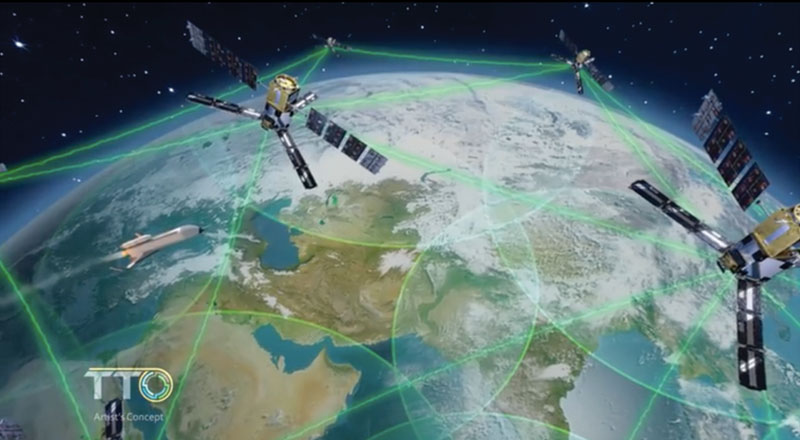
WASHINGTON — Inter-satellite communication is advancing as the industry moves toward larger constellations and a space layer that is increasingly interconnected. According to Northern Sky Research, approximately 85% of all satellites launched between 2020 and 2030 will be constellations. These satellites will not only have consistent contact with ground systems, but many will be communicating with one another directly. While satellite crosslink technology has been in use for decades by government and satcom providers, like Iridium, the proliferation of larger constellations has prompted investments in improved RF, microwave and optical inter-satellite links (ISLs) as providers work to make interconnected space networks a reality.
At the most basic level, ISLs transmit information at high speed to any satellite in the constellation, rather than mission data or commands being siloed in one satellite. Equipping each node to send and receive data, reduces the waiting time for a satellite to be in range of a ground station and gives operators more options to task a satellite closest to a downlink location, which enhances time-sensitive data operations, particularly in LEO.
Today, the reasons for employing ISLs vary by the constellation’s mission. Telecommunications and broadband providers are looking to enable faster transfer speeds, higher bandwidth and lower latency from LEO. Within the military, the links provide persistent connection, redundancy and real-time access to time-sensitive information. Links between spacecraft are also used for formation flying, or by earth observation satellites to transfer very large images at rapid speeds.
With their various applications, ISL proponents tend to favor interconnected constellations over other options, like multiple ground stations or relay satellites. It can be more affordable and practical to build out a larger network of ground stations for TT&C and mission download, though there are limitations on the amount of data downloaded. Companies, including AddValue and WARPSPACE, are deploying relay satellites for EO and TT&C, but the technology tends to be less useful for operations that demand low latency. Cost continues to be a barrier to broad adoption of inter-satellite links, particularly optical inter-satellite links (OISLs). There are also size, weight and power (SWaP) obstacles, regulatory hurdles for RF and issues with optical downlinks.
Will Lasers and Optical Links Become Widespread?
Traditionally, ISL or satellite crosslinks, have been dominated by RF and microwave technology and used in formation flying, TT&C, and data relay. While companies continue to develop and deploy RF solutions, breakthroughs in optical networking combined with demand for high-capacity data throughputs has fueled the growth of laser-based communications, or OISLs. This market is nascent and the technology is still largely experimental. Few players have graduated from development and testing to fully deployed systems. CACI recently demonstrated space-to-space optical communications links in LEO for the U.S. military, exchanging 200 Gb of data over roughly 100 km. To date, there are no large-scale operational OISLs—though several are scheduled to come online by the end of 2022 through 2024.
The promise of extremely high bandwidth, secure, optical communications has made more people optimistic about laser-linked constellations and the number of companies involved in the field is growing. If trends continue and the concept is proven with successful operations at a reasonable price point, the OISL market could grow to $3 billion over the next decade, according to Northern Sky Research.
Mynaric is one of few companies working to produce laser communication equipment at scale. Its next-generation CONDOR Mk3 terminal was designed to support LEO constellations and can transmit data over 8,000 km at speeds ranging from 2.5 Gbps to 1,000 Gbps. The company is focused primarily on equipment for satellite communications and broadband, or fielding “the enabling technology” that can close the digital divide globally, as Mynaric CEO Bulent Altan described the links in a recent interview with Constellations. In March, Mynaric was asked to provide CONDOR Mk3 terminals for 42 satellites being developed by Northrup Grumman for the Space Development Agency’s communication network. The typical communications constellation hosts four terminals per satellite, which has pushed the company toward mass production.
Perhaps one of the best-known applications of optical links is SpaceX’s Starlink system, which has equipped hundreds of its roughly 2,500 satellites with laser communications terminals. Since January 2021, the company has deployed dozens of optically-linked LEO and polar satellites to provide global broadband service. The technology is not yet operational, though. In early June, Elon Musk announced via Twitter that the laser terminals would be activated by the end of 2022, marking a milestone in the large-scale commercial use of OISLs. The optical links are expected to improve Starlink internet and reduce latency from roughly 55 milliseconds to 20 milliseconds, further demonstrating the viability of satellite internet, particularly in hard-to-reach locations.
OISLs, or optical crosslinks, are seen increasingly as an attractive solution for inter-satellite communications, largely because of their speed, high bandwidth and throughput capacity and ability to propagate in free space. However, high costs due to the immaturity of the market and SWaP continue to hinder widespread adoption. Optical communications also lack a single set of standards, leaving companies to develop their own. When successful, optical signals are secure and virtually invulnerable to interception, unlike radio and microwave communications, which are susceptible to jamming and frequency interference.
 Credit: DARPA
Credit: DARPA
Mix and Match: Optical Crosslinks, RF Downlinks
While optical terminals may be ideal in open space, they tend to fall short when connecting to ground systems. Cloud cover, turbulence and other atmospheric disturbances can block downlink connections, making lasers less reliable. Until the technology matures, satellites outfitted with optical links will likely have to communicate in multiple frequencies. The use of high-bandwidth optical crosslinks could increase the burden on RF downlinks. That could fuel new demand for high-data rate RF feeds or on-orbit data processing.
A few companies are developing payloads to communicate in multiple frequencies between the space and ground segments. The first generation of Kepler’s Aether satellites will use optical links and an “always-on” S-band ISLs for inter-satellite communication with a Ku-band terminal to serve as a high-capacity backhaul link to the ground. The design is intended to optimize compatibility among various missions, provide consistent communication among space assets and the ability to downlink large amounts of data back to earth.
Hedron (formerly Analytical Space) is developing the “world’s first hybrid optical/RF data relay network” for remote sensing satellite and EO constellations. The network will combine the technologies to enhance satellite communications, increase the amount of remote sensing data that can be offloaded and reduce latency when downlinking images.
RF: What’s Old is New
Certainly, carrying payloads with multiple terminals is not a solution for every constellation and not every operator is looking to be an early adopter of cutting-edge technologies. Several companies are boasting solutions that use existing technology to meet the growing demand for interconnected LEO constellations. Earlier this year, CesiumAstro released an S-band ISL called CommPack that it described as an “off-the-shelf solution” to assist with flight formation, configurations and collision avoidance. CommPack was recently selected by NASA for its Starling Program, a CubeSat mission to demonstrate autonomous swarm technologies.
The space-tech startup NSLComm developed a low-cost, low-weight deployable antenna for both space and ground communications. Earlier this year, NSLComm was tapped to develop a next-generation LEO constellation with Ka-band inter-satellite and satellite-to-ground links. The collapsible, large aperture design is intended to increase bandwidth without adding weight or size upon launch.
RF remains a reliable, versatile technology that continues to improve. Experiments with extremely high-frequency bandwidths (like Q/V-band, W-band and Ka-band) have demonstrated data rates in the range of 400 Mbps, making them worthy competitors with optical links in the future. One of the greatest advantages of RF/microwave ISLs is that the technology is well-established and there is a level of comfort within the industry after years of operational experience. At the same time, its widespread use and omnidirectionality increase the potential for interference, particularly if more constellations are equipped with RF ISLs. There are also bureaucratic hurdles and regulatory delays when waiting for licensing approval.
Inter-satellite communications networks have come a long way since the first ISL experiments in the 1970s but the technology still has a long way to go before it is widely adopted. With projections of 50,000 or more satellites orbiting the earth by 2030, communication and coordination between these objects will only become more important. At the same time, advances in terrestrial telecommunications and internet services are setting high expectations for interoperability, connectivity and networking capabilities users have come to expect. Increasingly, space systems will be expected to meet these expectations and interconnected satellites will be foundational to the performance and long-term viability of future constellations.
Explore More:
Laser Terminals are Shaking Up Space Networks
Supercomputers in Space: What Will the Future Bring?
Podcast: Laser Terminals as a Global Market Disruptor
Podcast: AI, Cybersecurity in LEO and a Future of 50,000 Satellites
